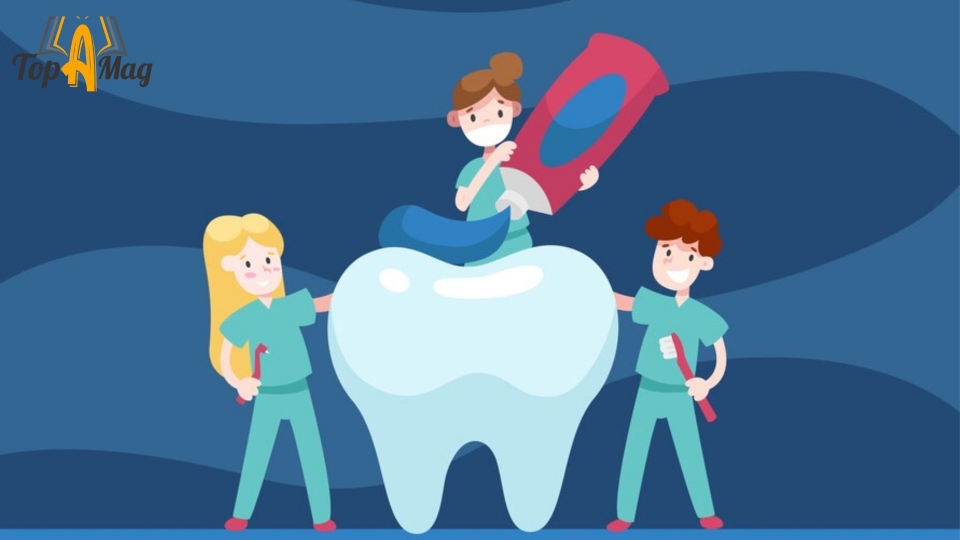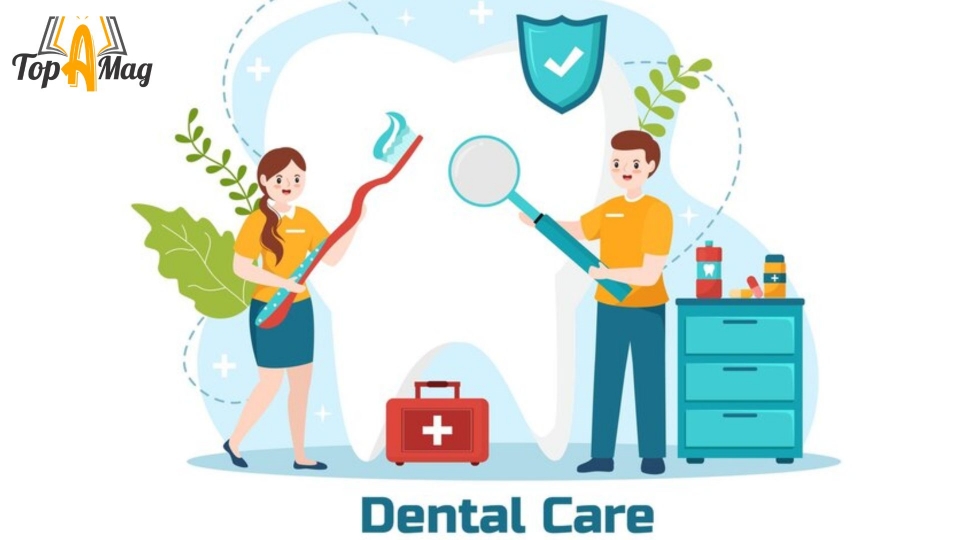Dealing with a loose tooth can be both worrisome and uncomfortable. Whether it’s due to an injury, gum disease, or other factors, knowing how to address this issue at home can be quite beneficial. This guide by The Top A Mag Team will delve into effective strategies for tightening a loose tooth naturally, offering practical tips and insights.
Understanding the Causes of a Loose Tooth
Before exploring solutions, it’s crucial to understand what might cause a tooth to become loose. Common reasons include:
- Gum Disease: Periodontal diseases can weaken the gums and supporting structures of the teeth. Gingivitis, the early stage of gum disease, can progress to periodontitis if left untreated, causing severe damage to the gums and bones supporting the teeth.
- Injury: Physical trauma to the mouth can result in a loose tooth. This can happen from accidents, sports injuries, or even biting down on something hard unexpectedly.
- Grinding Teeth: Habitual teeth grinding, known as bruxism, can wear down and loosen teeth over time. This can occur during sleep and often goes unnoticed until significant damage has been done.
- Poor Oral Hygiene: Inadequate dental care can lead to infections that weaken the teeth and gums. Plaque buildup, if not removed, can harden into tartar, which further exacerbates gum disease.

Maintaining Good Oral Hygiene
Oral hygiene is paramount in preventing and treating a loose tooth. Here are some essential practices:
- Brush Regularly: Use a soft-bristled toothbrush and fluoride toothpaste. Brush twice an afternoon to take away plaque and bacteria. Brush twice an afternoon to take away plaque and bacteria. Ensure you brush for at least two minutes, masking all surfaces of your tooth.
- Floss Daily: Flossing removes food particles and plaque between your teeth, areas a toothbrush can’t reach. Make it an addiction to floss at least as soon as a day, preferably before bedtime.
- Use an Antimicrobial Mouthwash: This can help reduce bacteria and keep your mouth clean. Choose and use an alcohol-free mouthwash to avoid drying out your mouth and causing further issues.
Dietary Adjustments
Whatever you consume has a vast effect on your oral health. Certain foods can help strengthen your teeth and gums:
- Calcium-Rich Foods: Dairy products like milk, cheese, and yogurt provide calcium, which strengthens teeth. Leafy greens, almonds, and tofu are also splendid assets of calcium.
- Vitamin C: Foods high in vitamin C, such as oranges, strawberries, and bell peppers, help maintain healthy gums. Vitamin C is crucial for the production of collagen, which helps repair and maintain the integrity of gum tissue.
- Avoid Sugary Foods: Sugar promotes the growth of bacteria that can cause decay and gum disease. Limit your intake of sugary snacks and drinks, and always brush your teeth after consuming them.
Home Remedies for Tightening a Loose Tooth
Several home remedies can assist in tightening a loose tooth. These methods are simple, natural, and often quite effective:
Saltwater Rinse
A saltwater rinse is an excellent way to reduce inflammation and kill bacteria in the mouth. Mix a teaspoon of salt in a glass of warm water and rinse your mouth for 30 seconds. Repeat this two to a few instances a day. Saltwater can help draw out infections and promote healing in the gums.
Turmeric and Black Pepper Paste
Turmeric has anti-inflammatory properties, while black pepper is antibacterial. Mix equal parts of turmeric and black pepper with a little water to form a paste. Apply this paste to the loose tooth and the surrounding gum area. Let it take a seat for a few minutes before rinsing your mouth. This paste can help reduce inflammation and combat bacterial infections.
Oil Pulling
Oil pulling is a historic exercise that involves swishing oil in your mouth to cast off pollutants and bacteria. Use coconut or sesame oil and swish it around your mouth for about 15-20 minutes daily. Spit out the oil and rinse your mouth very well. Oil pulling can help reduce plaque buildup and improve overall oral hygiene.
Amla (Indian Gooseberry)
Amla is known for its healing properties. Mix amla powder with water to create a mouthwash. Rinse your mouth with this solution to strengthen the gums and teeth. Amla is rich in antioxidants and vitamin C, which promote gum health care and healing.
Essential Oils for Oral Health

Certain essential oils can also help in maintaining oral health and potentially tighten a loose tooth:
- Tea Tree Oil: Has antibacterial properties. Mix a few drops with water and use it as a mouthwash. Tea tree oil can help reduce gum inflammation and fight infections.
- Peppermint Oil: Its antimicrobial properties make it useful for oral hygiene. Add a drop to your toothpaste or mouthwash. Peppermint oil can also provide a refreshing sensation and help reduce bad breath.
Exercises to Strengthen Your Teeth
Exercising your oral muscles can also aid in tightening a loose tooth. Simple exercises like chewing sugarless gum can stimulate the gums and teeth, promoting strength and stability. Additionally, you can try the following:
- Chewing on Hard Vegetables: Crunchy vegetables like carrots and celery can help massage the gums and improve circulation, promoting gum health.
- Tongue Pushes: Gently push your tongue against the roof of your mouth and hold for a few seconds. Repeat this exercise several times a day to strengthen the muscles supporting your teeth.
Herbal Remedies
Certain herbal remedies have been traditionally used to improve oral health and strengthen teeth:
- Guava Leaves: Chewing guava leaves can help reduce gum inflammation and tighten loose teeth. Guava leaves have antibacterial properties that can help fight oral infections.
- Clove Oil: Clove oil has been used for centuries to relieve tooth pain and improve gum health. Apply a small amount of clove oil to the affected area to reduce inflammation and pain.
Professional Treatment Options
While home remedies can be quite effective, it’s essential to know when to seek professional help. If your loose tooth is due to severe gum disease or injury, a dentist might suggest:
- Scaling and Root Planing: A deep cleaning technique to put off plaque and tartar from under the gum line. This manner enables lessening gum infection and promotes healing.
- Splinting: This involves bonding the loose tooth to adjacent teeth to provide stability. A dental splint can help distribute the biting force and give the loose tooth time to heal.
- Surgery: In extreme cases, surgical intervention may be necessary to restore the tooth’s support structures. Procedures such as bone grafting or tissue regeneration can help strengthen the foundation of a loose tooth.
Preventive Measures
Preventing a loose tooth involves maintaining excellent oral hygiene and making healthy lifestyle choices. Here are some preventive tips:
- Regular Dental Check-ups: Visit your dentist at least twice a year for routine check-ups and cleanings. Regular dental visits can help identify and address oral health issues before they become severe.
- Quit Smoking: Smoking can exacerbate gum disease, leading to loose teeth. Quitting smoking can appreciably enhance your oral health and average well-being.
- Use a Mouthguard: If you grind your teeth at night, using a mouthguard can protect your teeth. A custom-fitted mouthguard can help prevent further damage caused by bruxism.

Lifestyle Changes to Prevent Tooth Loss
Making certain lifestyle changes can also contribute to better oral health and reduce the risk of developing loose teeth:
- Stay Hydrated: Drinking plenty of water helps keep your mouth hydrated and promotes saliva production, which is essential for maintaining oral health.
- Limit Alcohol Consumption: Excessive alcohol intake can contribute to gum ailment and enamel decay. Moderation is key to maintaining healthy teeth and gums.
- Manage Stress: High-stress ranges can cause enamel grinding and clenching. Practice stress-relief techniques such as meditation, yoga, or deep breathing exercises to reduce the impact on your oral health.
Common Myths about Loose Teeth
There are many misconceptions about loose teeth and how to handle them. It’s essential to debunk these myths to avoid further damage:
- Myth 1: A loose tooth should be pulled out immediately. Fact: Pulling out a loose tooth without proper evaluation can lead to infection and other complications. Always consult a dentist.
- Myth 2: Only children experience loose teeth. Fact: Adults can also have loose teeth due to gum disease, injury, or other factors.
- Myth 3: Home remedies are not effective. Fact: While professional treatment is crucial, many home remedies can effectively support the health of your teeth and gums.
When to See a Dentist?
Knowing when to seek professional help is critical. Here are some signs that indicate it’s time to see a dentist:
- Persistent Pain: If you experience ongoing pain in your loose tooth or surrounding gums, consult a dentist.
- Swelling and Redness: Significant swelling and redness around the loose tooth can indicate infection, requiring professional treatment.
- Bleeding Gums: Frequent bleeding, especially when brushing or flossing, can be a sign of severe gum disease.
- Mobility: If the tooth becomes increasingly mobile, it’s essential to get it evaluated by a dentist.
Advanced Dental Treatments
In addition to basic treatments, dentists may offer advanced options for severe cases:
- Bone Grafting: This procedure involves adding bone material to strengthen the jawbone, providing better support for the loose tooth.
- Tissue Regeneration: Techniques such as guided tissue regeneration can help rebuild the bone and tissues supporting your teeth.
- Laser Therapy: Laser treatments can target and remove infected tissue, promoting healing and reducing inflammation.
Importance of Early Intervention
Addressing a loose tooth early on is crucial for preventing further complications and ensuring effective treatment. Early intervention can:
- Prevent Further Damage: The sooner you address a loose tooth, the less likely it is to experience further damage. Early treatment can prevent the issue from escalating and affecting neighboring teeth.
- Enhance Healing: Quick action can promote faster healing of the affected tooth and surrounding tissues. This can lead to a better prognosis and potentially avoid more invasive procedures.
- Reduce Pain and Discomfort: Timely treatment can alleviate pain and discomfort associated with a loose tooth, improving your quality of life and oral health.

Additional Tips for Maintaining Dental Health
Maintaining overall dental health is essential for preventing loose teeth and other oral issues. Here are some additional tips:
- Use Fluoride: Fluoride strengthens tooth enamel and helps protect against decay. Use fluoride toothpaste and do not forget fluoride treatments if recommended with the aid of your dentist.
- Avoid Chewing Hard Objects: Chewing on pens, ice, or other hard objects can damage your teeth and lead to looseness. Stick to softer foods and avoid putting unnecessary stress on your teeth.
- Practice Good Posture: Proper posture can influence your oral health. Maintain good posture to avoid placing undue stress on your jaw and teeth.
Regular Check-ups and Professional Cleaning
Routine dental check-ups and professional cleanings play a significant role in preventing and managing loose teeth. During these visits:
- Your Dentist Will Evaluate: Your dentist will assess the health of your teeth and gums, looking for any signs of gum disease or other issues that could contribute to a loose tooth.
- Professional Cleaning: Professional cleanings dispose of plaque and tartar that could cause gum disease and tooth instability. This process helps maintain a clean and healthy mouth.
Natural Remedies vs. Professional Treatments For Loose Tooth
While natural remedies can offer relief and support oral health, they should not replace professional dental care. Combining both approaches can be effective:
- Natural Remedies: Use home remedies as complementary treatments to support gum health and reduce inflammation. These methods can be beneficial in managing mild cases of loose teeth.
- Professional Treatments: For more severe issues or persistent problems, professional dental care is essential. A dentist can provide accurate diagnosis, advanced treatments, and preventive care to address the root cause of the problem.
Conclusion
Managing a loose tooth at home involves a combination of good oral hygiene practices, dietary adjustments, and natural remedies. By understanding the causes and employing effective home treatments, you can support your dental health and potentially tighten a loose tooth. However, it’s essential to recognize when professional intervention is necessary to prevent further complications and ensure optimal oral health.

